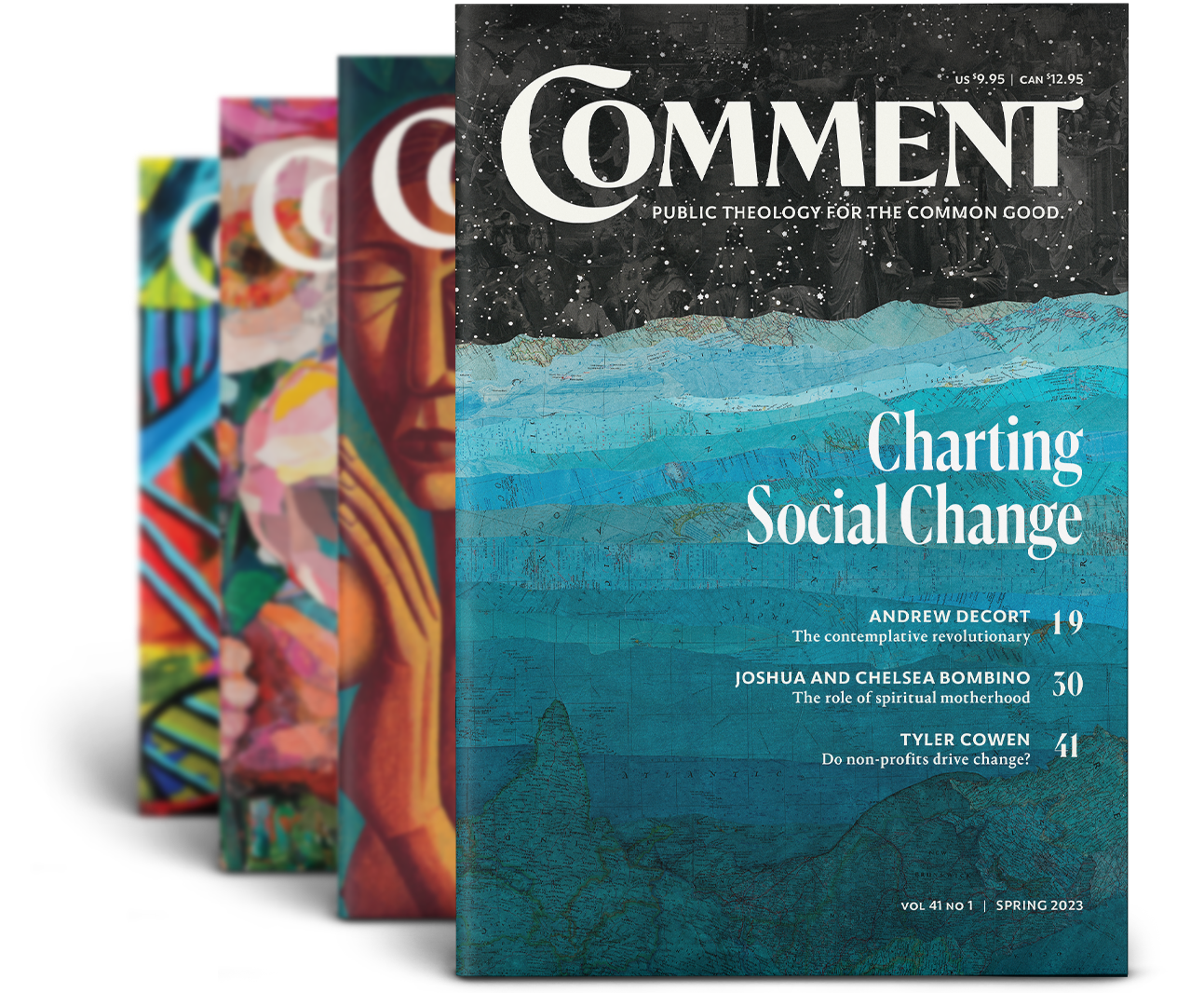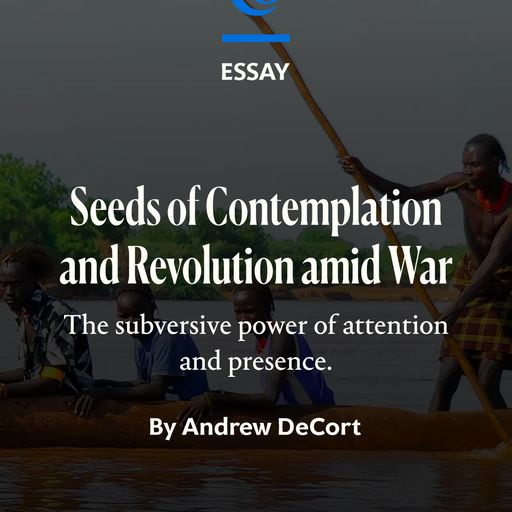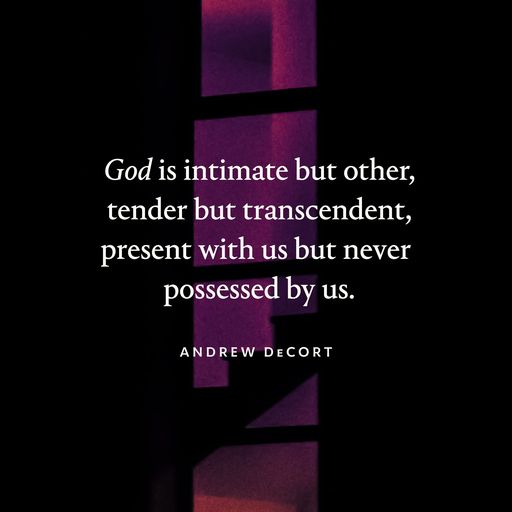Dear friends,
How might the prayer that Jesus taught us both energize and also challenge our vision of social change?
I explore this question in my essay “Seeds of Contemplation and Revolution amid War,” which was recently published in Comment Magazine. The essay begins by reflecting on the spiritual vision of Thomas Merton and shares some of the story of the Neighbor-Love Movement. It then looks at Jesus’s prayer as a practice of peaceful presence.
I hope you enjoy my essay below and also explore the other rich articles on Comment‘s website. Special thanks to Anne Snyder, editor-in-chief of Comment, for so warmly welcoming and so thoughtfully engaging my essay.
May you flourish,
Andrew

Seeds of Contemplation and Revolution amid War

“I believe that the true revolution must come slowly and painfully, not merely from the peasant, etc., but from the true artist and intellectual . . . from the thinker and the [person] of prayer.” —Thomas Merton, A Life in Letters
Questioning Change and Being There
In 1967, Pope Paul VI asked the Catholic monk Thomas Merton to write a letter from contemplatives to the world. It was a time of social upheaval and cold war. And yet here was a pope, representing a public institution, asking for those who spend their days in practices of prayerful listening to weigh in from the silence. The pope’s invitation was daunting, but Merton saw in it an opportunity for a needed dialogue between the interior and the exterior, a back-and-forth that seemed far too rare.
So he began. The fifty-two-year-old Merton explained that he had entered the monastery “in revolt against the meaningless confusion of a life in which there was so much activity, so much movement, so much useless talk, that I could not remember who I was.” And then he wrote, “Can I tell you that I have found answers to the questions that torment the [person] of our time? I do not know if I have found answers. . . . As I grow old in the monastic life and advance further into solitude, I become aware that I have only begun to seek the questions.”
Merton was serious. In another letter, this time to the historian Herbert Mason, he asked, “Who are we that we wake up in the morning expecting ourselves to ‘do something for’ somebody or for ‘the world’?”
It’s a resonant note to today’s suspicion of messiah complexes and paternalistic impositions marketed as “change.” But was Merton simply waxing eloquent on a contemporary form of escapist piety? He continued, “I can only try to be someone for [people]. This I very much want to be. And the doing part need only be an expression that I am there. This is very much the Foucauld universal brother idea. . . . I think the only thing that will help is being a more or less helpless brother, in Christ.”
For Merton, self-interrogation was key. The presence we emit—who we are and the way we are there for others—is more vital than the roles we assume and the tasks we fulfill (“the doing part”). But how can this be? Is the world-shaking vitality of this presence really most alive when we are “more or less helpless”?
Neighbour-Love and Civil War
I come to this with serious questions and the people of Ethiopia in my heart. For the last two years, Ethiopia has been devastated by what Merton called “a contagion of conflict” and an utterly heart-shattering civil war.
An estimated 500,000 people have died through fighting, starvation, and lack of access to medical care due to the Ethiopian government’s blockade against the Tigray region. Around a million people are in danger of starving to death. Several million people are now displaced and homeless. The Washington Post reported in March 2022, “The world’s deadliest war isn’t in Ukraine, but in Ethiopia.”
In 2018, many of us in Ethiopia could sense that something truly terrible was escalating. Horrifying videos of public executions were going viral, and hundreds of thousands of people were being displaced from their homes. Genocidal language was gaining ground.
And I was burning to do something. So I resigned from my position at the Ethiopian Graduate School of Theology in Addis Ababa, where I taught theology and ethics. I then transitioned into work as a peace advocate in Ethiopia’s polarized public life.
Around this time I was invited to speak to two hundred youth at city hall in Dire Dawa, near the Somali border. As I crossed the city, I saw massive tents sheltering ethnic minorities from a neighbouring city. Youth had gone door to door in that city, warning these people to get out or prepare to be attacked, and so they fled for their lives. These displaced people graphically represented how identitarian hostility was threatening to tear Ethiopia apart. So I spoke to the youth in Dire Dawa about loving our enemies and how this strange approach to conflict could help heal our communities.
Afterward, a young woman dressed in a beautiful white hijab approached me. Her name was Ferdosa. She said, “Andrew, no one has ever told me to love my enemies before. Starting today, I will love my enemies and teach others to love their enemies.” Against cultural norms, she held my hand, and we raised our hands together, almost like we were making a shared commitment, or covenant, before a love we could not embody on our own.
Meeting Ferdosa in a city sheltering displaced people was a clarifying moment. How many other Ferdosas, I wondered, were sick of conflict and longing for a different way of seeing and treating “the other”? Soon after, my wife Lily and I, together with my colleague Dr. Tekalign Nega, launched the Neighbor-Love Movement. Our mission was to inspire young Ethiopians to see and treat others as precious neighbours in this time of supercharged othering. We defined “othering” simply as seeing others as unrelated or less than ourselves, and we identified it as one of the primary forces threatening to consume Ethiopia in blood, tears, and ruin.
We began traversing Ethiopia, in-person and online, and inviting Ethiopia’s youth to commit to our movement’s covenant: “Today I covenant to love my neighbor as myself. Every woman, man, and child is my neighbor across every boundary and identity. I choose to see and treat my neighbors with value, respect, and practical compassion. Today I say yes: I am an ambassador of neighbor-love.”
Ninety-seven percent of Ethiopians say that their faith is “very important” to them. So we rooted this moral vision in Ethiopia’s ancient Jewish, Christian, Islamic, and democratic traditions. We established seven practices that activate our bodies as instruments of peace. These practices start with our eyes, by seeing the other person as our neighbour, and our ears, by listening with patience, even in disagreement. Our sacred traditions affirm that the other is not our enemy but our neighbour.
We held conferences with students on university campuses that had experienced conflict, including in the city from which the people had fled to Dire Dawa. We hosted dialogues at local libraries and schools and spoke at events with a business incubator, civil society organizations, and academic institutes. We published articles and produced a large social media campaign in local languages to spread this vision of others as precious neighbours rather than enemies. We designed a daily meditation to help our audience internalize seeing even the ethnic, religious, and political other as a neighbour with precious value.
Thousands of youth and several senior leaders signed our movement’s covenant and pledged to embody our seven practices. Our social media campaign reached over twenty million Ethiopians and presented an alternative vision for being human together against the hate speech and dehumanization overflowing online and in local media. Ethiopia’s Ministry of Science and Higher Education, inspired by our message, invited us to produce a video curriculum on disinformation and ethics that was slated to be used by all forty-five of Ethiopia’s public universities.
But disaster was not averted, and the war exploded on November 4, 2020. Two years in, the violence has been catastrophic, destroying the lives of countless women, men, and children in Tigray and other regions in Ethiopia like Amhara, Oromia, and Afar. I have never witnessed such rancorous hate and raw hopelessness in our beloved Ethiopia over nearly twenty years.
The Neighbor-Love Movement’s grassroots work continues amid the conflict and near-criminalization of peacemaking in Ethiopia. But I confess that the prospect of “change”—what Merton called “doing something”—has never felt more dizzying and elusive.
I find myself asking hard questions: Has our work achieved anything? Do we humans change? Can societies face themselves and move in a new direction? Or are we hell-bent on plunging over the precipice—whether in a suicidal rage or messianic fantasy?
Perhaps this is why Merton’s words resonate with me so acutely. I have become suspicious of “answers.” The quick fixes and self-assured promises of “salvation”—whether in Ethiopia, America, Russia, or elsewhere—have proved to be addictive illusions and dangerous ego trips.
Merton’s self-interrogation strikes me as vital: Who are we? More particularly, who are we becoming through our daily practices? “A [person] who is not at peace with himself,” Merton wrote in No Man Is an Island, “necessarily projects his interior fighting into the society of those he lives with, and spreads a contagion of conflict all around him.” Are we people whose presence emits peace, or are we people whose presence projects our “interior fighting” and spreads “a contagion of conflict” all around us?
Much as I find Merton’s observation perceptive, it is becoming harder and harder for me not to follow the gravitational pull to absorb and emit the contagion of conflict as Ethiopia’s civil war struggles to heal and rumours of civil war spread in the United States. We see a siege mentality being stoked, whole groups of people being labelled as enemies, humiliation becoming a popular political tactic, and victory in a zero-sum game being sold as “salvation.” It is deeply disturbing to see American political culture following patterns similar to what I saw in Ethiopia leading up to the civil war. In this environment, it’s intensely difficult to stay soft-hearted and resist reproducing the same problem: generalizing, blaming, and dismissing “them” as the “enemy.”
As the stakes rise, “doing something” can be far easier than intentionally facing this existential self-interrogation of who I am becoming. Externalizing the problem onto others and “doing more” to try to “solve it” shields me from facing my own pain, smallness, and temptation to reinforce the very things I claim to reject. At times I have found my mind thinking thoughts that lie at the root of othering, violence, even genocide: “If we could just get rid of those people, then things might be better. They’re the problem. Stop talking to them. Cut them out of your heart and life.”
The reality is that “the doing part” is ultimately unsustainable, perhaps even counterproductive and dangerous, without this disruptive self-examination. When I look inside, who is Andrew becoming? Hard-hearted? Cynical and fatalistic? Tormented and enraged? Reactionary and revengeful? Addicted to being “on” and driven by inertia? Am I absorbing and emitting the very “contagion of conflict” I claim to hate and work to overcome?
The Practice of Being There with Jesus
As I wrestle with these questions, the prayer that Jesus taught at the beginning of his public movement has been grounding and vital to who I’m becoming.
Prayer at its heart is about what we do with our attention. It’s the opening of our inner life to divine transcendence with focused but unforced presence. In it, we embrace that vulnerable risk of listening and being transformed by something more fundamental than human power—by God’s honesty, wisdom, and love.

In my experience prayer works, but it primarily works on us. The psychiatrist Curt Thompson writes, “Ultimately, we become what we pay attention to. . . . Practice tends to make permanent.” This attentive, practiced becoming is the anchor of all authentic prayer.
We see this at work very profoundly in the life of Jesus.
Jesus experienced severe trauma in an extremely polarized society. He survived a political massacre as a baby, he grew as a refugee far from home, and then he was raised in impoverished obscurity. Soon after Jesus launched his movement, he was labelled, demonized, and attacked with death threats. In the end, Jesus was arrested, tortured, and murdered in public.
The reason for such opposition is not hard to find. At the heart of Jesus’s movement was a call to radical change, or metanoia—that spiritual revolution unleashed by first embracing a beginner’s mind. Jesus called for this metanoia with disruptive declarations like “Blessed are the peacemakers” and countercultural commands like “Love your enemies” (Matthew 5:9, 44). For people who benefit from dividing and conquering, making peace and loving the enemy is intolerable treason. When you love the enemy, you become the enemy.

Unsurprisingly, then, the religious and cultural power brokers insisted, “We found this man subverting our nation.” Weaponizing fear, they mobilized their base with the promise that violence would “save the nation” (see Luke 23:2). (Rather than salvation, this religious nationalism led to a catastrophic war with Rome that destroyed Jerusalem in AD 70.)
During Jesus’s slow execution, we might expect shattered passivity or damning reactivity from this thirtysomething. The childhood trauma, the chronic public humiliation, the slow drip of resentment—all of this would seemingly paralyze Jesus or come raging out of him in these final moments when he was literally naked to the world.
But Jesus’s creative agency—the way he embodied and emitted presence—remained his own and irrepressible. He didn’t shrink or explode. He remained somebody and truly there, even as a “helpless brother” on an imperial lynching tree.
What came out of Jesus was not a contagion of conflict but words of radical forgiveness (“Father, forgive them”), rebellious hope (“Today you’ll be with me in paradise”), and ultimate trust (“Father, into your hands I commit my spirit”). No wonder Hannah Arendt, herself a secular Jew, wrote in On Revolution that Jesus was “the only completely valid, completely convincing” embodiment of goodness in history.
How did Jesus become this kind of person and emit this kind of presence even in anguish?
As I mentioned, Jesus began his movement by teaching a short prayer to his wildly diverse band of followers. This prayer was Jesus’s invitation to daily meditation. It distilled the essence of his spirituality in fifty carefully crafted words.
It seems to me that Jesus became what he paid attention to. Practice made permanent. Jesus promised that this prayerful consciousness could sustain human flourishing in the face of shattering disappointment and excruciating pain (see Matthew 7:24–25). It appears that Jesus’s promise stood the test of his own trauma. His prayer enabled him to emit a presence of forgiveness, hope, and trust, even when he was stripped naked and murdered.
Jesus’s short prayer unfolds in seven movements that subtly respond to seven of our fundamental questions. Let me simply mention three and what they can do.
Our Father: A Practice of Divine Belovedness
Jesus’s prayer begins by responding to the primal question, Who is God? For Jesus, God is not an abstract idea to believe, a religious doctrine to defend, or a cultural identity marker to project. God is a personal Presence to address and encounter, even in our most vulnerable and painful experiences. This is the God whose singular message to Jesus was, “You are my beloved child; I delight in you” (see Matthew 3:17; 17:5; John 12:28).
Baptized in divine belovedness, Jesus internalized his own unconditional value. Before he started “the doing part,” God’s loving presence liberated him from needing to impress or intimidate others to secure his worth. That psychological “contagion of conflict” was washed away.
Out of this embrace of divine belovedness, Jesus was able to use that little word “our” with the most unlikely and unliked people. The crowd that Jesus invited to call God “our Father” included the sick, foreigners, the demonized, the pagan, the urban and rural, the religious and self-righteous (Matthew 4:23–25). Likely for the first time in their lives, these people learned to see one another no longer as strangers or enemies but as beloved children of our Father—and thus themselves as a new we.
People who practice this divine belovedness by opening themselves to God grow into a different kind of presence characterized by resilient tenderness. They no longer need to impress or intimidate others. They can simply be with others. A new grammar of togetherness emerges from their minds and mouths that can heal othering. Imagine silently invoking “our Father” the next time you get into an argument with someone and reminding yourself that they are not an enemy but a child of God just like you are.
Hallowed Be Your Name: A Practice of Radical Reverence
But when we take God’s name on our lips, we often do so with presumption and pride. All too easily we insist that God is on our side and that God will help us defeat our enemies. “God” gets weaponized in our conflicts.
So how should we talk about God? Jesus teaches us to silence this arrogance and confess, “Hallowed be your name.” God is not a trump for our tribe or a mascot for our ambitions. God is holy, the great mystery at the heart of all reality who stands above us and condemns our violence.
When we talk to God with Jesus, we are not self-justified and aggressive. Instead, we become humble and acutely aware of how infinitely different God is from us. God is intimate but other, tender but transcendent, present with us but never possessed by us.
People who practice hallowing God by giving their attention to holy mystery grow into radical reverence. They know that they don’t know. They grasp that they can’t grasp. They have been liberated from the weaponization of “God” for human causes. They disavow speaking of “God” with presumption.
Your Kingdom Come: A Practice of Prophetic Imagination
Even so, Jesus doesn’t get stuck in deconstruction. Tightening the brilliant spiritual tension of his prayer, he next unfurls our imagination and ignites our desire with the question, What do you want? Here Jesus teaches us to pray, “Your kingdom come on earth as it is in heaven.”
For Jesus, desiring the kingdom isn’t code for crusades, colonization, or Christian nationalism. Jesus teaches that the kingdom looks like care for the hungry, the thirsty, the naked, the foreigner, the imprisoned, and the sick—people who sound to me like victims of Ethiopia’s civil war or people so desperate for a new start that they’d leave everything behind to try to enter the United States. According to Jesus, the way we respond to these people is the way we respond to divinity. This is how we answer God’s invitation to that wildly diverse party waiting on the other side of death’s door, or decline it for something less joyful (Matthew 25:31–46).
Praying for the kingdom, then, places vulnerable, easily erased people at the very centre of our hearts. Their security and dignity become our daily desire—indeed, our very first request to God.
In this way, praying with Jesus becomes a therapy for our desires and the world we’re making. The endgame of the universe is not winner takes all. It’s a global party in which the nobodies—and those who ache for their well-being—finally feel at home. Prophetic imagination gets unlocked and energized.
Jesus’s prayer continues with four more practices that build on and mature the first three. Each one is about what we do with our attention, how we practice presence in our relationships, and thus who we’re becoming as people in the world. Together, they integrate into the fierce flourishing that Jesus embodied even in his death.
To Be Someone for Others
As I pray with Jesus and continue advocating for peace in Ethiopia, I am acutely aware of being “a more or less helpless brother, in Christ,” however culturally queer it may be to admit this.
We live in a world wracked with multiple wars and rumours of wars. A contagion of conflict is spreading. And the patterns across contexts are disturbingly similar: extreme polarization, dehumanizing othering, and charismatic personalities promising us “salvation” in return for our unquestioning loyalty. The result never changes and is nowhere clearer than in Ethiopia today: blood, tears, and ruin.
With Merton, I’ve lost interest in pushing “answers.” Instead, I’m drawn to seek the questions, especially Merton’s question: “Who are we that we wake up in the morning expecting ourselves to ‘do something for’ somebody or for ‘the world’?”
This question isn’t a convenient exemption. It’s a crucial self-interrogation. Are we fighting inside ourselves and spreading this contagion, perhaps even as we claim to “do things” for people or even for the world? Or are we becoming a healing presence like Jesus in which “the doing part need only be an expression that [we are] there,” even when we’re dying? Who are we?
In 1968, a year after Merton wrote his letter from contemplatives to the world, James Baldwin suggested before the World Council of Churches, “The revolution which was begun two thousand years ago by a disreputable Hebrew criminal may now have to be begun again by people equally disreputable and equally improbable.”
I believe Baldwin was right and remains so. And perhaps the way to restart Jesus’s revolution in our own time of upheaval is to learn how to practice his prayer again.
The irony is that many people, religious or not, can recite this prayer from memory. It’s already downloaded. But few of us actually know what it means and how to activate its revolutionary potential to change our lives.
Perhaps Jesus meant business when he, a craftsman by trade, designed this tightly integrated prayer, taught it to that wildly diverse crowd of sacred siblings, practiced it himself for several years, and then went to his death with forgiveness, hope, and trust flowing out of him. Against all odds and appearances, the most successful social movement in history was just beginning.
As I ponder Jesus’s life, the mystery of social change, and our pandemic of conflict, I find myself asking this disquieting question: Can we get crucified and still emit a presence of forgiveness, hope, and trust? Perhaps the only “leaders” worth following in the quest to “do something for the world” are more or less helpless sisters and brothers who can do that.
*** This article was based on my new book Flourishing on the Edge of Faith: Seven Practices for a New We. Available at BitterSweetBooks, Audible,






